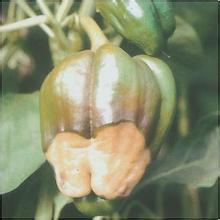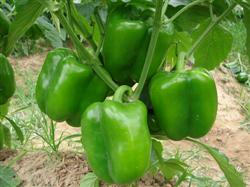What are the cultivation methods of sweet pepper?

What are the cultivation methods of sweet pepper? Please introduce that the cultivation of sweet pepper can be divided into early spring and winter stubble, and the methods are as follows: early spring stubble: 1. cultivate strong seedlings: big arch shed: hotbed seedling in late December, planting in early March; solar greenhouse: sowing from late November to early December, planting in mid-late February. Now most vegetable farmers order seedlings, it is recommended to choose a well-known, reputable seedling factory to book strong seedlings. 2. Colonization: 1. Base fertilizer: the safe planting period of sweet pepper is that the ground temperature of 10 cm in the greenhouse is more than 12 ℃. 8-10 square of mature high quality organic fertilizer was applied in advance, and 50-100kg of calcium superphosphate, 40-50kg of potassium sulfate and 3-5kg of trace elements such as boron, iron, zinc and molybdenum were applied. two。 High ridge cultivation and reasonable close planting: ridge height about 20cm, large row spacing 85-90cm, small row spacing 60cm, plant spacing 45-50cm, about 2000 plants per mu. 3. Planting: hole planting, it is appropriate to choose sunny morning planting, ditch watering, water stable seedling planting. Then the soil will be flat with the surface. Four. post-planting management: 1. Temperature management: the sweet pepper was not ventilated within 10 days after planting, and the temperature was maintained at 22-32 ℃ during the day and more than 15 ℃ at night. With the increase of the outside temperature, the ventilation began after the seedling was slowed down. When the temperature in the greenhouse reached 30 ℃ at noon on a sunny day, the vent was closed when it dropped to 26 ℃ in the afternoon. The temperature was maintained at 25-30 ℃ during the day and 15-18 ℃ at night. When the external temperature has stabilized above 15 ℃, it can be ventilated day and night. In the summer high temperature season, further increase the ventilation rate, can roll up the greenhouse film around the arch shed and the front foot of the winter greenhouse, and retain the top greenhouse film to shade and prevent rain. The row can also be covered with wheat straw or rice straw to cool down. two。 Fertilizer and water management: start ploughing 3-4 days after planting in order to increase the soil temperature. Early watering as little as possible, if watering, it is best to pour dark water, in order to improve the ground temperature and slow the seedlings. From the door pepper fruit, every 7-10 days to water, full fruit every 2-3 days to water, avoid flood irrigation. In addition to base fertilizer in early spring cultivation, one fertilizer was applied after sitting on the fruit of door pepper, opposite pepper and four mother pepper, and organic fertilizer and chemical fertilizer were used alternately. 3. Plant adjustment: wipe off the side branches below the door pepper in time, leave the 3-4 trunk branches with uniform growth to grow upward, the other side branches leave 1-2 fruit to pick the heart, the leaf buds that occur between the leaf axils should be erased as soon as possible, leave as many flowers as possible, and bear more fruit. And rope to prevent lodging and improve permeability. In the middle and later stage of growth, some overlapping branches, crowded branches and overgrown branches can be removed, and the old leaves, diseased leaves and deformed fruits in the lower part of the plant can be removed in time. 4. Cover sunshade net: in the middle and later stage of sweet pepper growth, high temperature, strong light, pepper is prone to virus disease, sunburn disease, etc., can be shaded by sunshade net, can cool 1-2 ℃, the degree of light reduction depends on the type of sunshade net. The mulching effect can also reduce the disease, improve the yield and quality in the later stage, and prolong the growth period. 5. Timely harvest: use door pepper to adjust plant growth. If the plant is too prosperous, it can be picked late, otherwise early. Usually 35-40 days after flowering. The fruit is long, the pulp is thicker, the pericarp is hard and shiny, the fruit color becomes darker and harvested best before turning red, at this time the fruit is heavy and resistant to storage and transportation. 6. Prevention and control of diseases and insect pests: epidemic disease: use Jinreidomir 600800x liquid, Amicida 1500-2000 fold liquid or daconine 600x liquid spray for prevention; if you have suffered from epidemic disease, use Jinreidi or poisonous alum 600800x liquid to irrigate roots, 100-150ml per plant, generally 1-2 times can completely control the development of the disease. Root rot disease: the preventive measures are the same as those of the blight. The disease can be irrigated with Shileshi and Shigao 600x liquid, with a dosage of 100-150ml per plant. Virus disease: prevention is the main, pay attention to anti-stab-sucking pests such as whitefly and aphids at seedling stage, and DDV fumigation shed is used before ventilation is sealed with insect control net or before planting. Virus A, Zhiyanling, virus Qing and 83-resistance enhancers can be used to alleviate the development of virus diseases. Botrytis cinerea: alternately sprayed with daconine 600x solution, Shile 1000-1500 fold solution, amiseda 1500-fold solution or carbendazim 800-1000 fold solution, if the stem is sick, the original solution or diluted 5-fold solution can be used to smear the disease spot. Aphids, whitefly: use Aktai 5000-7000 times liquid plus 2000 times Kung Fu liquid, imidacloprid + cypermethrin spray, this method can also control thrips, mites, night flies and so on. Winter stubble: 1. Temperature management: before the deep winter (that is, before late December), it is mainly to adjust the temperature of strong trees, and the cover of grass is based on temperature, keeping it at 25-30 ℃ during the day and 15-17 ℃ at night; during the deep winter (from late December to early February), it is mainly heat preservation, with 25-28 ℃ during the day and as far as possible at night, so that the lowest temperature is above 8-10 ℃. Thicken the mulch, cover the grass with the old film to prevent rain on rainy days; after the deep winter (after mid-February), the temperature rises, manage according to the appropriate temperature, and gradually increase the ventilation rate. two。 Lighting: in the range of maintaining the lower limit of temperature before deep winter, the grass canopy can be uncovered early and late in the deep winter, keep the greenhouse film clean, and hang the reflective screen, which can increase the air temperature and ground temperature in the shed. According to the increase of light within 1-2m of the reflective screen, the plant is robust and disease-proof, and the sweet pepper increases by about 10% compared with those without the reflective curtain. 3. Fertilizer and water management: after sitting, door pepper can be watered according to soil conditions and applied with 10kg potash and 20kg compound fertilizer, which should be completely dissolved in advance and then used; after watering, the principle of dry and wet should be mastered, and compound fertilizer or potash fertilizer 20kg should be applied with water per mu after each harvest. In the deep winter season, small water should be poured under the plastic film, not flooding. Fertilizer topdressing should be carried out a small number of times, mainly biological fertilizer. After entering the last ten days of January, the average interval of watering was 10-15 days, and the compound fertilizer was 30-40kg per mu. After the middle of February, the temperature increased and the plant transpiration increased, which could increase the watering times. 4. Other management: especially the late management, can refer to the cultivation in early spring. Note: the above cultivation measures are for reference only, and the specific operation methods are expected to depend on the local planting habits and climatic conditions. Click to get more sweet pepper planting techniques click to get more vegetable planting techniques
- Prev

How to prevent sunburn and navel rot from growing sweet peppers in summer?
How to prevent sunburn and navel rot from growing sweet peppers in summer? Please introduce the method that sweet pepper in greenhouse often has rotten fruit, which is mainly caused by sunburn and navel rot. Sunburn is mainly due to the direct sunlight on the fruit surface or the appearance of dew on the greenhouse film and fruit in the morning.
- Next

How to trim the sweet pepper?
How to trim the sweet pepper? Please introduce the reason why the sweet pepper cultivated in late autumn can be pruned appropriately, the old plant can be renewed and rejuvenated, and there will be another fruit peak in autumn, so as to increase the yield of sweet pepper per mu. The specific method is: after the peak period, from late July to early August, put the sweet pepper for the second or third time.
Related
- Where is it suitable to grow horseradish in China? it is expected to see the middle altitude horseradish in Alishan.
- How to prevent tomato virus disease reasonably? (Control methods included)
- Many people like to plant towel gourd on the balcony. What are the main points of this method and management?
- What crops can chili peppers be mixed with?
- Fertilization techniques and matters needing attention in Tomato
- What are the grafting techniques for peach seedlings in spring?
- Harm and control methods of root swelling disease of Chinese cabbage
- What are the pests of sweet potatoes? How to prevent and cure it?
- Symptoms, causes and Control methods of navel Rot in Tomato
- The cause of "Cucumber rotten bibcock" in Farmers' planting Cucumber and its Control Plan

